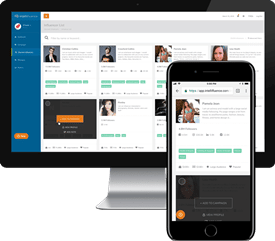Last Updated on June 9, 2020
Welcome to what has been over four months of effort. From August through December of 2016 we’ve been compiling data and covering a wide variety of topics related to how a brand or agency could use influencer marketing in their overall marketing mix to increase sales. The culmination of the 14 series articles is what I now believe to be a very comprehensive guide and the eventual first half of a book on influence. For your reading ease this guide is designed in a table of contents format with executive summaries of each piece, allowing you to immediately skip to sections you’re most interested it. If you are new to influencer marketing we recommend starting at the beginning and reading the articles in order. They are as detailed as I could make them and contain supporting information not presented in the executive summaries. Have questions, comments, or love letters? Please like/share and comment below and I’ll do my best to answer them in a timely manner.


What is Influencer Marketing?
Exec Summary
A primer of how influencer marketing came to be, from its roots as word of mouth marketing to present day format. Learn the differences between aspirational, authoritative, and peer influencers, why influencer marketing can be adopted by any B2C or B2B business, and what makes for a successful campaign. Finally, dive into a breakdown into where influencers are most active today, and our thoughts on the trending direction of influencer marketing as a function of overall digital marketing: hint, up and to the right.
Who Should Use Influencer Marketing
What is the quality of customers acquired from influencer marketing?
Reach of influencers in online marketing in the United States, by industry
What Makes for a Successful Campaign?
Platforms perceived by marketers as the most effective for influencer marketing
Distribution of Instagram users in the United States by age group
How are bloggers driving traffic to their posts?
Is influencer marketing the future of social selling?
Social media marketing spending in the United States from 2014 to 2019
Are you expecting your influencer marketing budget to increase or decrease over the next 12 months?
How can you get started using influencer marketing to sell more product?


Why should influencer marketing be part of your strategy?
Exec Summary
Should influencer marketing be a part of your plans? Dig into its efficacy compared to other forms of digital marketing and its cost effective benefits. To understand who to target, included is a primer on how to build a buyer persona based on existing sales data, extrapolating out to a larger set of data using LinkedIn. Next, learn how influencer marketing differs from advertising, how to use it to build brand loyalty, and why it is great for creating promotable content. Finally, grasp the reality that your competitors may already be using influencer marketing or have plans to start.
Efficacy of peer influencer marketing vs other marketing types
What is the quality of customers acquired from influencer marketing?
Is influencer marketing cost effective?
How to determine buyer personas
Influencer marketing isn’t advertising
Building brand loyalty and thought leadership
Influencer marketing provides for promotable content
Your competitors are already doing it
Reference: Shane Barker


How to set goals for your influencer campaign
Exec Summary
Without goals, marketing campaigns are listless and potentially a waste of time and money. Learn the BSQ method (think big, act small, move quickly) as well as the SMART methodology (specific, measurable, actionable, relevant, timeline) to help in the goalsetting process. Next, work through some boosting strategies to get more out of your goals; plus, an explanation of how B2B organizations can also partake, dispelling the myth that influencer marketing is for B2C only.
BSQ is goal setting for those that think agile
Reference: Dennis Goedegebuure
Simple campaign boosting strategies to get more out of your goals


Who Exactly are You Trying to Influence?
Exec Summary
Explore the four factors governing consumer behavior (cultural, social, personal, and psychological) as well as their respective components (geographic, language, historical, religious culture and cultural environmental), (family, socioeconomic status, and social groups), (age, lifestyle, and personality), and (motivation, perception, learning, beliefs and attitudes). Using Up Hail as a case study, the four factors and their component considerations are used to create a buyer persona that could be used as the target buyer/user in an influencer marketing campaign.
The 4 factors influencing consumer behavior
Case study: Cultural factors for Up Hail
Reference: Avi A. Wilensky
- Case study: Cultural geography factor for Up Hail
- Case study: Cultural language factor for Up Hail
- Case study: Cultural historical & religious factor for Up Hail
Case study: Social factors for Up Hail
- Case study: Social economic factor for Up Hail
- Case study: Social family factor for Up Hail
- Case study: Social group factor for Up Hail
Case study: Personal factors for Up Hail
- Case study: Personal age factor for Up Hail
- Case study: Personal personality factor for Up Hail
- Case study: Personal lifestyle factor for Up Hail
Case study: Psychological factors for Up Hail
- Case study: Psychological motivation factor for Up Hail
- Case study: Psychological perception factor for Up Hail
- Case study: Psychological learning factor for Up Hail
- Case study: Psychological beliefs and attitudes factor for Up Hail


Which Social Channel Will Bring Sales for Your Business?
Exec Summary
Which social channel is the best fit for your campaign? Explore using a usefulness matrix that examines the merits based on open reach, visual nature, casual acceptance, professional acceptance, and capacity for details. Using case studies from Antavo, Hubspot, Tinder, and Fanatics, see how the channel selection differs based on product type and B2B vs B2C focus.
Social Channel Usefulness Matrix
- Usefulness Matrix: Open Reach
- Usefulness Matrix: Visual
- Usefulness Matrix: Casual
- Usefulness Matrix: Professional
- Usefulness Matrix: Detailed
B2B Enterprise Buyers Case Study: Antavo
Reference: Timi Garai
B2B Smaller / Mid-sized Business Case Study: Hubspot
Reference: Matthew Barby
B2C Mobile Apps Case Study: Tinder
Reference: Brian Norgard
B2C Fashion Case Study: Fanatics
Reference: Dennis Goedegebuure


Determining the Right Influencer Type for Your Campaign
Exec Summary
Referencing the earlier posts, learn which of the three influencer types (aspirational, authoritative, and peer) would work best for you by using another usefulness matrix. To explain the proper times to use each influencer type, walk through case studies generated for Murray Newlands, Slack, and Search Engine Journal.
Influencer Type Usefulness Matrix
- Influencer Type Usefulness Matrix: Reach
- Influencer Type Usefulness Matrix: Relevancy
- Influencer Type Usefulness Matrix: Trust
- Influencer Type Usefulness Matrix: Inform
- Influencer Type Usefulness Matrix: Commerce
- Influencer Type Usefulness Matrix: Emotion
Reference: Murray Newlands
Reference: Slack
Reference: Scott Rosenberg
Reference: lorenbaker
Reference: Kelsey Jones


Time to Pick the Right Product Influencers
Exec Summary
Learn how to calculate which product influencer is best suited for your campaign based on the simple equation of Outcome = (Reach * Engagement * Relevance) — Cost. Using Joe S vs Damien T as influencers, see how the decision to use one over the other differs based on the variable inputs for different situations. The primary reason for this calculation is to dispel the myth of audience size being everything when considering which influencers to work with.
- Probability of Influence: Reach
- Probability of Influence: Engagement
- Probability of Influence: Relevance
- Probability of Influence: Cost
- Probability of Influence Case Study


How to Pitch Influencers
Exec Summary
Pitching influencers is like selling any product or service; with that analogy, learn the difference between cold and warm influencer outreach as well as how to create a good, converting pitch that provides value. Next, an explanation of how to adjust the pitch during testing and a closing plea on the importance of being responsive as a function of successfully closing the pitch.
What constitutes a good pitch?


Local vs National: Which Influencer Audience Type is Better?
Exec Summary
Learn when you should opt for a local influencer vs a less geographically centric influencer, an usefulness matrix exists to determine the importance of location by exploring geocentricity, geobias, geospecificity, and geoactivity. To explain varying scenarios, case studies for Starwars.com, Miami Fishing Charters, and BloomNation are used.
GEO Audience Usefulness Matrix
- GEO Audience Usefulness Matrix: Geocentricity
- GEO Audience Usefulness Matrix: Geobias
- GEO Audience Usefulness Matrix: Geospecificity
- GEO Audience Usefulness Matrix: Geoactivity
Reference: Howard Lerman
Reference: Andrew Shotland
Reference: Jeff Preston
Case Study: Miami Fishing Charters
Reference: Todd Malicoat
Reference: Eric Wu ( ・ㅂ・)و ̑̑


So You Got Your First Review; Now What?
Exec Summary
After a review is received, there’s a process to undertake to ensure that the review meets the criteria agreed upon in the pitch, whether revisions by the influencer are required, and promotional strategies to use (co-opting content, audience engagement, amplification, retargeting, native advertising, and email) to ensure maximum value is achieved with the review.
- Promote it: Co-opt
- Promote it: Engage
- Promote it: Amplify
- Promote it: Retarget
- Promote it: Native
- Promote it: Email
Reference: Tony Adam
Reference: Sujan Patel


Influencer Negotiation: What is Fair?
Exec Summary
Is it worth it to negotiate with an influencer? That depends entirely on the perceived value exchange. If negotiation is necessary, choose between a relational and transactional approach. Finally, learn how to negotiate with the influencer using the Harvard Business Review 9 step guide to negotation (determine satisfactory outcome, identify opportunities to create mutual value, identify your BATNA, improve your BATNA, get the decision maker, prepare, adapt as necessary, establish fairness, and alter the process if necessary).
9 steps to getting the deal done
Reference: Harvard Business Review
- 9 Step: Determine satisfactory outcome for the influencer review
- 9 Step: Identify the opportunities to create value
- 9 Step: Identify your BATNA and reservation price
- 9 Step: Improve your BATNA
- 9 Step: Get the decision maker
- 9 Step: Study like the test is tomorrow
- 9 Step: Prepare for process flexibility
- 9 Step: Establish fairness
- 9 Step: Alter the process
Negotiate with an eye to the future


How to Maximize Exposure on Your Product Reviews
Exec Summary
Using the compulsion marketing concept (pairing marketing tactics in order to use different psychological triggers: (aspirational influence, authoritative influence, peer influence, retargeting + social CPM/PPC, mega content campaigns, and email), learn how to maximize product review exposure through case studies for Bose and Ulta Beauty.
Reference: Dennis Goedegebuure


Round Two: Use the Same Reviewers or Get New Ones?
Exec Summary
When deciding to utilize influencer marketing on a second campaign, one needs to decide whether to use the same influencers or find new ones. The decision to do so can be reached using a decision matrix that considers product uniqueness, product change, habitual use, ideal audience, the benefit of repetition, and the existence of new influencers to consider. To explain the concept, Frank Body is used as a case study.
New or Old Influencers Decision Matrix
- New or Old Influencers Decision Matrix: unique product
- New or Old Influencers Decision Matrix: unique with change
- New or Old Influencers Decision Matrix: habitual
- New or Old Influencers Decision Matrix: ideal audience
- New or Old Influencers Decision Matrix: repetition benefit
- New or Old Decision Matrix: new discovery
- Influencer Decision Case Study: Frank Body
Reference: Sandra Kirwan


Post-Mortem: Why We Test
Exec Summary
A post-mortem is a retrospective analysis on the goal, the process taken, and the conclusion. Learn the benefits of using post-mortems to tie back into one’s goalsetting and how to successfully perform a post-mortem step-by-step, as well as the types of questions to ask to ensure the next campaign yields even better results.
How to Perform a Successful Post-Mortem
- Post-Mortem: Take notes
- Post-Mortem: Team meeting
- Post-Mortem: Discuss the data
- Post-Mortem: Listen to other learnings
- Post-Mortem: Stick to your agenda
As you can see, influencer marketing can be applied to enterprise international megacorps and local small businesses alike, both those that sell to C-level executives and to neighborhood grandmothers. If you apply the lessons learned from this guide it is my hope that you’ll have all the success I believe you can have.
In our next 15 part series, we’ll cover everything an individual needs to know to become a top tier influencer, which will serve to act as a companion piece pairing to this guide. To be in the know when these are published, follow the Intellifluence blog for updates. To close, like with the articles, I’ll conclude with a pitch: if you’ve now decided that influencer marketing is right for you, why not work with the most affordable influencer network around; get started today and put the power of peer influencers to work for your brand or the brands you represent.

Joe, CEO and Co-Founder of Intellifluence, has over 25 years of experience in SEO, leading several successful marketing companies and providing expert consultation. He is the author of The Ultimate Guide to Using Influencer Marketing, which is available as an eBook or in print.






